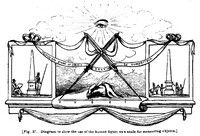At HOLKHAM, about twenty years ago, the lofty obelisk seen from the portico, appeared to be surrounded by shrubbery, but on a nearer approach, I found that these apparent shrubs were really large trees, and only depressed by the greater height of the obelisk. A similar instance occurs at WELBECK; the large grove of oaks seen from the house across the water, consists of trees most remarkable for their straight and lofty stems; yet, to a stranger, their magnitude is apparently lessened by an enormous large and flourishing ash, which rises like a single tree out of a bank of brushwood. When I was first consulted respecting WENTWORTH HOUSE, the lawn behind it appeared circumscribed, and the large trees which surrounded that lawn appeared depressed by four tall obelisks: these have since been removed, the stately trees have assumed their true magnitude, and the effect of confinement is done away. I have illustrated these observations by the example of an obelisk [fig. 37], because its height being indeterminate, it may mislead the eye as a scale; since, according to its size and situation, the very same design may serve for a lamp-post, a mile-stone in the market-place of a city, an ornament to a public square, or it may be raised on the summit of a hill, a monument to a nation's glory.

